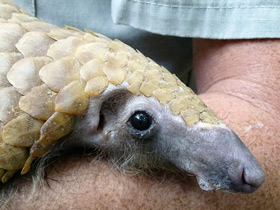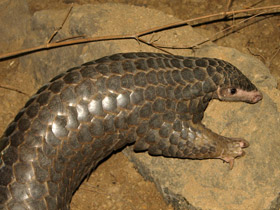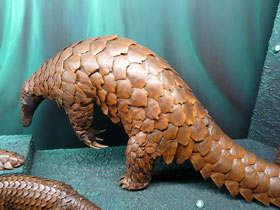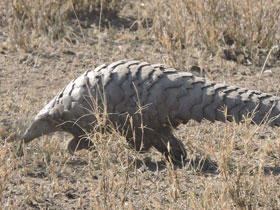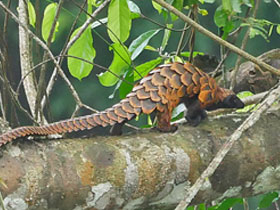Pangolins or scaly anteaters (the order Pholidota)
Pangolins, sometimes known as scaly anteaters, are mammals of the order Pholidota (/fɒlɪˈdoʊtə/). The one extant family, the Manidae, has three genera: Manis, Phataginus, and Smutsia. Manis comprises four species found in Asia, while Phataginus and Smutsia include two species each, all found in sub-Saharan Africa. These species range in size from 30 to 100 cm (12 to 39 in). A number of extinct pangolin species are also known. In September 2023, nine species were reported.
Etymology
The name of order Pholidota comes from Ancient Greek ϕολιδωτός – "clad in scales" from φολίς pholís "scale".
The name "pangolin" comes from the Malay word pengguling meaning "one who rolls up" from guling or giling "to roll"; it was used for the Sunda pangolin (Manis javanica). However, the modern name is tenggiling. In Javanese it is terenggiling; and in the Philippine languages, it is goling, tanggiling, or balintong (with the same meaning).
In ancient India, according to Aelian, it was known as the phattáge (φαττάγης).
Description
The physical appearance of a pangolin is marked by large, hardened, overlapping, plate-like scales, which are soft on newborn pangolins, but harden as the animal matures. They are made of keratin, the same material from which human fingernails and tetrapod claws are made, and are structurally and compositionally very different from the scales of reptiles. The pangolin's scaled body is comparable in appearance to a pine cone. It can curl up into a ball when threatened, with its overlapping scales acting as armor, while it protects its face by tucking it under its tail. The scales are sharp, providing extra defense from predators.
Pangolins can emit a noxious-smelling chemical from glands near the anus, similar to the spray of a skunk. They have short legs, with sharp claws which they use for burrowing into ant and termite mounds and for climbing.
The tongues of pangolins are extremely long, and like those of the giant anteater and the tube-lipped nectar bat, the root of the tongue is not attached to the hyoid bone, but is in the thorax between the sternum and the trachea. Large pangolins can extend their tongues as much as 40 cm (16 in), with a diameter of only about 0.5 cm (1⁄5 in).
The body length of these strange cone-shaped creatures ranges from 30 to 90 cm, the length of the tail is about the same and the weight ranges from 4.5 to 27 kg.
Its body is covered with large, rhombic, horny scales, placed one on top of the other; only the muzzle, belly, underside and inside of the legs are covered with short, tough wool. These scales are movable and their rear edge is pointed. As they wear out, they are replaced by new ones, but their number remains constant.
Pholidota are grey-brown in colour and their limbs have five toes with large digging claws.
The snout of these animals is elongated, the mouth opening is small and the teeth are partially or completely absent.
Their small eyes are covered by thick eyelids to protect them from insect bites; their tongue is long (up to 40 cm) and covered with sticky saliva. The muscles that move the tongue are so large that they extend through the thoracic cavity to the pelvis.
The stomach of the Pholidota is lined with keratinous epithelium, with a fold covered with horny teeth extending into the cavity.
Like birds, Pholidota swallow pebbles, which help them to crush their food. All of the above characteristics are adaptations for termite feeding.
Habitat and way of life
Pholidota are common in equatorial and southern Africa (four species) and Southeast Asia (also four species). They all belong to the same genus Manis. They are both terrestrial and arboreal and inhabit open areas and tropical forests. Pholidota are nocturnal and during the day hide in deep burrows (up to 7.5 m) or under tree hollows and canopies.
They move very slowly; the fastest of the Pholidota (steppe lizards) is only 3.5 to 5 km/h. Like kangaroos, they can climb on their hind legs, supported by their tail.
When in danger, the Pholidota curls into a ball. Only a large predator, such as a tiger or leopard, will be able to uncurl it. However, if it senses this, it emits a foul-smelling fluid from its anal glands, which drives its enemies away. The Pholidota has poor eyesight and hearing, but an excellent sense of smell.
Nutrition and peculiarities
The Pholidota feeds exclusively on termites and ants. Research has shown that the saliva of the Pholidota has a honey-like smell that is attractive to insects; cotton wool moistened with this saliva attracts termites and ants. Pholidota stomachs contain 150 to 2000 g of insects (mainly 2-3 species). These animals eat almost no other food, which makes it difficult to keep them in captivity.
Interestingly, the anthills not only serve as food for the Pholidota, but also as a kind of "cleaning station" for parasites. The lizard sits near the angry ants and spreads the scales. The insects crawl under them and begin to sting Pholidota, irrigating its skin with formic acid. After a while, the Pholidota quickly presses the scales against its body and crushes the ants, at which point the cleaning procedure is over.
Reproduction and numbers
These animals live alone and reproduce once a year. Pregnancy lasts 120-150 days. African lizards have one young, Asian lizards one to three, 17.5 cm long and weighing 420 g. The newborns are well-developed, well-developed and well-fleshed. The newborns are well developed, covered with soft scales that harden after a few days. After one month, the young Pholidota are already eating insects.
Locals kill Pholidota for their meat and scales, which are said to have medicinal properties. The number of these animals is low everywhere.
Taxonomy
Order: Pholidota Weber, 1904:
- Genus: †Euromanis Gaudin, Emry & Wible, 2009:
- Family: †Eurotamanduidae Szalay & Schrenk, 1994:
- Suborder: Eupholidota Gaudin, Emry & Wible, 2009:
- Superfamily: Manoidea Gaudin, Emry & Wible, 2009;
- Family: Manidae Gray, 1821;
- Family: †Patriomanidae Szalay & Schrenk 1998 [sensu Gaudin, Emry & Pogue, 2006];
Incertae sedis
- Genus: †Necromanis Filhol, 1893:
- Superfamily: †Eomanoidea Gaudin, Emry & Wible, 2009:
- Family: †Eomanidae Storch, 2003.
Threats
Pangolins are in high demand in southern China and Vietnam because their scales are believed to have medicinal properties in traditional Chinese and Vietnamese medicine. Their meat is also considered a delicacy. 100,000 are estimated to be trafficked a year to China and Vietnam, amounting to over one million over the past decade. This makes them the most trafficked animal in the world. This, coupled with deforestation, has led to a large decrease in the numbers of pangolins. Some species, such as Manis pentadactyla have become commercially extinct in certain ranges as a result of overhunting. In November 2010, pangolins were added to the Zoological Society of London's list of evolutionarily distinct and endangered mammals. All eight species of pangolin are assessed as threatened by the IUCN, while three are classified as critically endangered. All pangolin species are currently listed under Appendix I of CITES which prohibits international trade, except when the product is intended for non-commercial purposes and a permit has been granted.
China had been the main destination country for pangolins until 2018, when it was reportedly surpassed by Vietnam. In 2019, Vietnam was reported to have seized the largest volumes of pangolin scales, surpassing Nigeria that year.
Pangolins are also hunted and eaten in Ghana and are one of the more popular types of bushmeat, while local healers use the pangolin as a source of traditional medicine.
Though pangolins are protected by an international ban on their trade, populations have suffered from illegal trafficking due to beliefs in East Asia that their ground-up scales can stimulate lactation or cure cancer or asthma. In the past decade, numerous seizures of illegally trafficked pangolin and pangolin meat have taken place in Asia. In one such incident in April 2013, 10,000 kilograms (22,000 pounds) of pangolin meat were seized from a Chinese vessel that ran aground in the Philippines. In another case in August 2016, an Indonesian man was arrested after police raided his home and found over 650 pangolins in freezers on his property. The same threat is reported in Nigeria, where the animal is on the verge of extinction due to overexploitation. The overexploitation comes from hunting pangolins for game meat and the reduction of their forest habitats due to deforestation caused by timber harvesting. The pangolin are hunted as game meat for both medicinal purposes and food consumption.
Folk medicine
Pangolin scales and flesh are used as ingredients for various traditional Chinese medicine preparations. While no scientific evidence exists for the efficacy of those practices, and they have no logical mechanism of action, their popularity still drives the black market for animal body parts, despite concerns about toxicity, transmission of diseases from animals to humans, and species extermination. The ongoing demand for parts as ingredients continues to fuel pangolin poaching, hunting and trading.

















